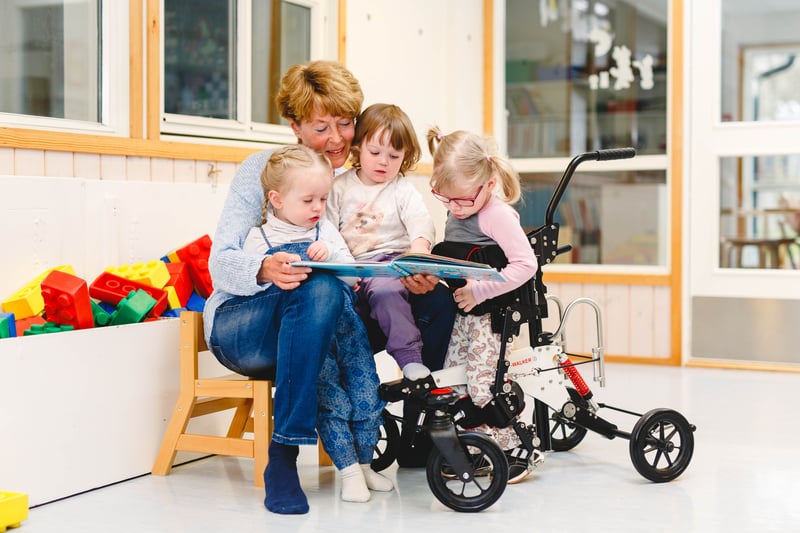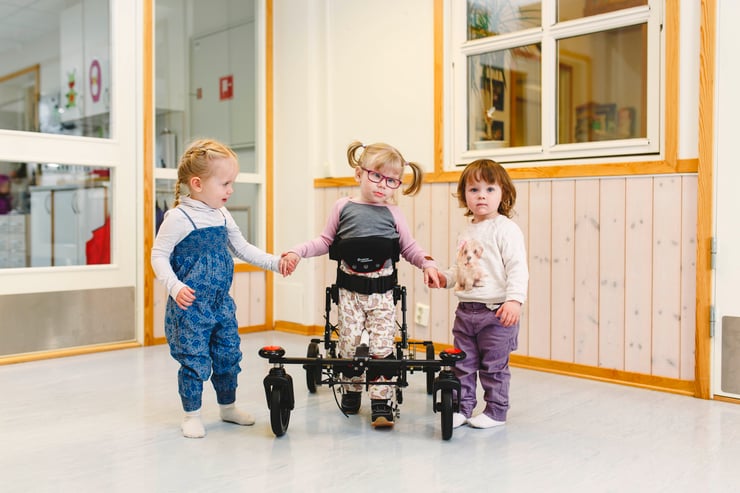
“Why? ...Yeah but, whyyy?!”
Small children ask a lot of questions; it’s in their nature. As they grow they want to understand the world around them, one full of mystery and intrigue. But for most youngsters, they possess very limited experiences of people with disability, so it’s entirely natural for them to have questions - often many of them.
Thinking about how to explain your child’s disability to other children can be a stressful task as you worry how to handle a potentially sensitive discussion. You must walk a delicate tightrope of explaining why your child is physically different from most other children, whilst avoiding creating the impression that it is something out of the ordinary. You have to explain why your child may sometimes be treated differently, for example if they’re unable to participate in certain activities, but also why this does not mean your child has to be viewed as different by the other children.
Show them how being different is actually very normal
Maybe you have a sibling who is struggling to fit into important family routines, or maybe there are classmates whose curiosity will not be satisfied without some good answers. Whatever the situation, we have put together some useful strategies you can use to help you through this talk when the time comes. To help us with this task we turned to Leif Olsen Øyen, a principle at the Enggrav Kindergarten and primary school in Norway. After many years’ experience, he is an expert in responding to “but whyyy?!” from curious young minds.
Because children have a very limited frame of personal reference to put things into context, it can take them time to absorb scenarios that are different to the ones they are familiar with or expect. So your overall aim should be to emphasise that we are all different in one way or another, and that we each have unique qualities; disability is simply one type of difference, just like any other within the broad spectrum of people and life in general.

1. Address children’s curiosity directly
- Try to answer all the questions they might have. Be honest and try to be as open minded as they are! Remember, children’s main intent when asking questions is to understand, not judge
- Be honest about how your child was born with, or developed a medical condition, that leaves them unable to physically do everything other children can - but focus on the fact that your child has the same needs and wants as everyone else
- Frame the discussion positively - talk about what your child can do, not what they may not be able to do
- Emphasise the fact that children with disabilities are still able to have very fulfilling lives. You can explain that they can still do many of the things you or I can do, it’s just that they may need to do it in a slightly different way
2. Avoid going into too many complex details
- Sometimes, going into lots of detail, for example talking about specific symptoms or other difficult medical information can go wrong, with the possibility you can become too emotional in trying to control a difficult situation and may not be able to provide the answers the way you want
- Leif points out that children tend to be very much focused on the ‘here-and-now’, and what is happening in front of them right now. Therefore, try to construct answers that are focused on what the children are saying, and their questions related to what they are seeing around them
- This way you can avoid having to give the “big and difficult” answers too early, by avoiding more general, wider topics that may be too abstract for the children to fully understand just yet
For example, if they ask why your child cannot walk “like everyone else”, respond by focusing on the fact that your child want to walk around like any other children, but they have problems to do so because of problems with the muscles. This just means they might need help walking or moving around with walking aids. This focuses on what they can do, not what they cannot. - If it is followed up by the question “but why?”, you can simply say that your child simply has their own way of doing things, and that we all need our own way of doing things sometimes

3. Try to choose your words carefully
- Think about the words and terms you should use ahead of time
- You can talk openly about the fact that your child faces certain challenges, but this should always be in positive terms, not negative language that implies something too problematic
- Make sure to describe the disability in as simple terms as possible, using neutral phrases that avoid moral or ethical questions; where possible try to avoid long, difficult or unfamiliar words the children will struggle to understand (like complex medical jargon for example)
4. Show, don’t just tell
- Showing children exactly how a walking aid or other movement devices work and help your child to move can be a really effective way to offer children greater insight into the situation
- This can help them to see the situation as different as opposed to challenging
- Through a practical demonstration you can highlight the fact your child is normal, they just do some things in a different way
5. Be firm in not allowing any joking or bullying behaviour
- Be aware of what your own children and their peers say around the issue of disability. Try to pay attention to the words and phrases they use
- If you hear you child or their friends use negative terms, you should calmly explain this type of behaviour is unacceptable and that words can be hurtful, just the same as if someone said something hurtful about them
- If you find your child is being bullied, the goal should be to help the other kids understand that while your child may be different, there is nothing wrong with that
6. Teach sensitivity, empathy and awareness
- Don’t leave questions unanswered - even if you can’t give an answer right away. If a child has specific question about your child’s disability, where you’re either unsure, or you feel needs a more detailed response, you can offer to help them research the answer online
- Highlight that your child has the same need to express happiness, anger, sadness and so on, as any other child does. Also, that your child has just as many opportunities and potential as their friends and peers. The underlying theme should be one of demonstrating that “all children are children”
Ultimately, the compassion you are able to communicate in talking to other children about what they may find to be a confusing topic can help to put them at ease. By taking the lead in showing them that it is not a taboo topic, they will see they the have room to explore and discover more about the world around them.
Just like any other complex conversation you might have to have with a young child, a small amount of consideration beforehand can help you enter into a dialogue with confidence rather than discomfort. And the children will feel at ease seeing you have strong, reliable answers for them, helping them to understand that both disability and their questions around it are perfectly normal.

The author worked as Head of Marketing for Made for Movement for 7 years before she pursued other adventures in her own company. Trine Roald has over 20 years of international experience within a variety of industries. As Head of Marketing for Made for Movement she was passionate about communicating stories and know-how featuring possibilities for improving the quality of life among people with severe disabilities.
In this blog, we delve into universal design to help you understand and recognise how its principles, when implemented, can foster...
A disability entails the loss of, damage to, or deviation from bodily or psychological functions, in the form of mental, physical,...
Epilepsy is a serious neurological brain disorder that causes recurring seizures and is common in children with cerebral palsy. There...
Hear from us from time to time and learn new things
